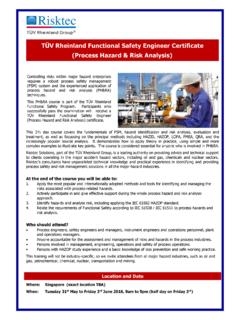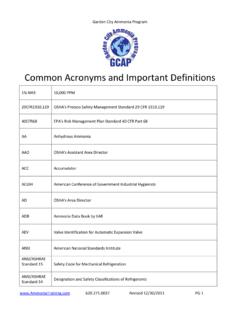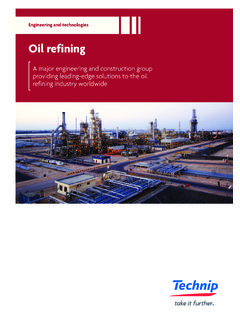Transcription of Behavioural safety and major accident hazards : magic ...
1 Behavioural safety AND major accident hazards : magic BULLET OR SHOT IN THE DARK? Martin Anderson MErgS, EurErg, MIOSH HM Specialist Inspector of Health & safety (Human Factors) UK Health And safety Executive In recent years there has been an increase in the use of behaviour modification (BMod) approaches to safety . These interventions generally involve the observation and assessment of certain behaviours, usually those of front-line personnel. The rationale behind Behavioural safety approaches is that accidents are caused by unsafe behaviours. These approaches are based on behaviourist theories, which can be summarised by behaviour that is strongly reinforced will be maintained . There are reports of some successes with behaviour modification in a range of environments, including the process industries.
2 Such approaches have a number of advantages in addition to reducing incidents, including increased communication about safety , management visibility and employee engagement. However, these programmes tend to focus on intuitive issues and personal health and safety , ignoring low probability/high consequence risks. The author proposes that the causes of personal safety accidents may differ to the precursors to major accidents and therefore Behavioural safety programmes may draw attention away from process safety . Furthermore, the tendency is to focus on individuals and fail to address management behaviour, thus excluding activities that have a significant impact on safety performance.
3 This paper discusses the usefulness of behaviour modification approaches, particularly in managing major accident hazards , and provides guidance for companies that may be considering embarking on such a programme. KEYWORDS: human factors, Behavioural safety , major accident hazards , safety management, COMAH INTRODUCTION major accidents in the oil, gas and chemical industries are by definition high consequence and include major fires, explosions and toxic releases. They are also, thankfully, relatively infrequent. The main legislation focussing on these hazards in the UK are the Control of major accident hazards Regulations 1999 COMAH. Sites that come under these regulations are required to take all measures necessary to manage their major accident hazards .
4 The Hazardous Installations Directorate of the Health and safety Executive inspect COMAH sites, assess safety reports submitted by the so-called top tier sites and investigate incidents on all major hazard sites. This paper is based upon personal experiences of regulating safety on sites that come under the COMAH regulations. CAUSES OF major ACCIDENTS In any incident there are usually two types of causes: direct causes that occur immediately prior to the undesirable event; further away, either in time or space, there are underlying causes that contributed to the immediate, direct event. Historically, many incidents and accidents in all major hazard industries were seen as the fault of someone at the sharp end the last person who touched the equipment.
5 This view is less common today, particularly in incident investigations, although it is still dominant in efforts to prevent major accidents. This paper therefore argues that there exists an anomalous situation on one hand industry increasingly recognises that incidents have underlying causes distant from the person who is directly involved; however, on the other hand, resources to prevent such incidents are often targeted at front line staff. Reviews of reports into recent major incidents and of research examining the causes of such incidents around the globe tells us the most common causes behind these events. For example, over the years Professor Trevor Kletz has written several accessible books analysing high-profile accidents such as Bhopal, Flixborough, Piper Alpha and Seveso, aiming to show how lessons can be learnt.
6 Discussing the focus on front line staff in reported causes of accidents, Kletz states that: Managers and designers, it seems, are either not human or do not make errors (Kletz 2001, )1. Recent research by Collins and Keeley (2003)2 shows that although the immediate causes of major incidents frequently involve human error of operators or maintenance personnel, the reasons that these errors occurred in the first place were the responsibility of those more senior in the organisation. This research reviewed 718 loss of containment incidents randomly selected from approximately 2500 investigations. Extracts from this research make interesting reading when considering Behavioural safety interventions. For example, of 110 incidents due to maintenance, only 17 were due to a failure to ensure that planned maintenance procedures were followed (a front line issue and therefore possibly candidates for a Behavioural intervention), but 93 were due to a failure by the organisation to provide adequate maintenance procedures (a management issue, which would not be addressed by the majority of Behavioural interventions).
7 Of the incidents analysed, only were due to procedural violations personnel deliberately not following procedures. Collins and Keeley state that the cause of any incident or accident , including loss of containment, can usually be traced back to a failure of safety management . Similar findings were reported in early research on causes of loss of containment incidents by Bellamy et al., 19893. On 25th September 1998, two people were killed in an explosion and fire at the Esso Longford facility in Australia, which led to severe disruption of gas supplies to the State of Victoria s industry and retail customers for two weeks. Longford should be seen as a wake-up call for all of the world s major hazard installations; there are many lessons to be learnt from this incident.
8 The Royal Commission Report (1999)4 into the accident found that the direct cause of the accident was failure of an exchanger when hot oil was re-introduced after the vessel became cold, following loss of oil circulation during a major process upset. This lead to brittle fracture and the release of hydrocarbon vapour that subsequently ignited, causing explosion and fire. Esso was convicted of breaches of the Occupational Health and safety Act 1985 (Vic.) and fined a total of $2 million in the Victorian Supreme Court on 30 July 2001. The judge said that responsibility for the tragedy rested solely with the company. The Longford Royal Commission Report concluded that other contributory factors included: failure to conduct a HAZOP study or similar to identify hazards ; lack of operating procedures for the situation experienced; inadequate training of personnel; a reduction in supervision; transfer of experienced engineers offsite to Melbourne; a general desire by Esso to reduce operating costs.
9 The conclusion from a report into lessons learnt from the Esso Longford disaster by the Institution of Engineers, Australia concluded that: a combination of ineffective management procedures, staffing oversights, communication problems, inadequate hazard assessment and training shortfalls combined to result in a major plant upset with consequential tragic loss of life (Nicol 2001, )5. Furthermore, Nicol reports that these issues are relevant to all major hazard facilities; they are not unique to the oil and gas industry. He also reports that other factors increase the chances of disasters, including the increasing age of major hazard plants and an increase in the age profile of the workforce.
10 The HSE report into the three incidents at BP Grangemouth in May and June 2000 was published in 20036. The Foreword to this report, by Dan Mitchell (Head of Land Division, HSE), states that: Recent work reviewing thirty years of Large Property Damage Losses in the Hydro-carbon Chemical Industries .. shows that there was little new in the events leading to the BP Grangemouth incidents . It stated in this report that underlying the failures were a number of weaknesses in the safety management systems on site over a period of time. There were a number of key lessons for major accident hazard sites in this report; including that: Lesson 1: major accident hazards should be actively managed to allow control and reduction of risks.















